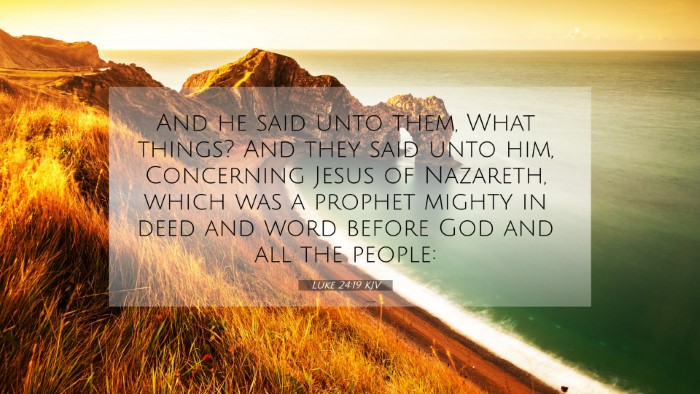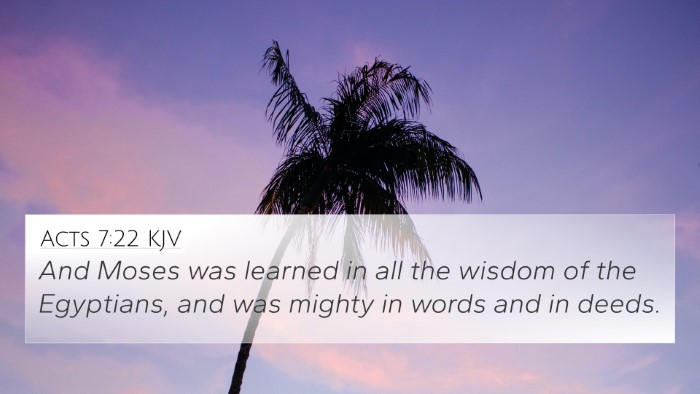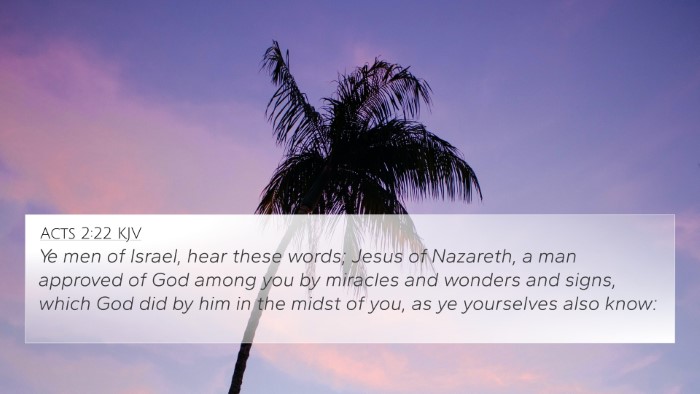Understanding Luke 24:19
Luke 24:19 states: "And he said unto them, What things?" This simple yet profound question asked by Jesus opens a dialogue that reveals much about His nature and the way He engages with His followers.
Contextual Background
Following His resurrection, Jesus encounters two of his disciples on the road to Emmaus. They are discussing the recent events surrounding His crucifixion and the reports of His resurrection. Jesus, appearing as a stranger, initiates a conversation that highlights the themes of recognition, doubt, and faith.
Commentary Insights
-
Matthew Henry's Commentary:
Henry emphasizes the tenderness and compassion of Christ in His inquiry. Jesus does not immediately reveal His identity but allows the disciples to express their confusion and disappointment. This aspect of the verse highlights the importance of understanding before revealing the truth.
-
Albert Barnes' Notes:
Barnes points out that Jesus’ question serves as an invitation for the disciples to articulate their thoughts and feelings. Through this engagement, they begin to process the events they’ve witnessed, which is critical for their spiritual growth.
-
Adam Clarke's Commentary:
Clarke notes that this interaction illustrates the method by which Jesus teaches. By asking questions, He encourages reflection and deeper understanding among His followers. This method fosters a personal connection between Christ and the disciples.
Thematic Connections
This verse reflects several broader themes within the scripture:
- Discovery through Dialogue: The dialogue is crucial for revealing truth.
- Faith and Doubt: The disciples are grappling with their faith, displaying human doubt in the face of miraculous events.
- Recognition of Christ: Their eventual recognition of Jesus emphasizes the transformative power of faith.
Bible Cross-References
Luke 24:19 connects with numerous other scriptures that enrich its meaning:
- John 20:14-16: The moment when Mary recognizes Jesus after His resurrection.
- Matthew 28:17: The doubt of the disciples when they see the resurrected Christ.
- Mark 16:12: Jesus appearing in another form to two of them as they walked and went into the country.
- Acts 1:3: Jesus showing Himself alive after His suffering, by many infallible proofs.
- Luke 24:30-31: The breaking of bread leading to the recognition of Jesus.
- Isaiah 53:3: Prophetic indication of the suffering Messiah whom they were discussing.
- Psalms 119:18: An appeal for enlightenment in understanding the Scriptures.
- James 1:5: A call to seek wisdom from God, which aligns with discernment in recognizing truth.
- 1 Corinthians 15:14-15: The significance of the resurrection central to Christian faith.
- Romans 10:17: Faith comes by hearing, indicating the importance of discourse in belief.
The Importance of Cross-Referencing
In studying Luke 24:19, practitioners can employ cross-referencing tools to delve deeper into scripture. This approach provides a more comprehensive understanding of themes and connections between biblical texts. Here are some key aspects to consider in cross-referencing:
- Contextual Comparison: Identifying how different verses speak to similar themes amplifies understanding.
- Historical Connections: Linking Old Testament prophecies with New Testament fulfillments enriches biblical narrative.
- Topical Studies: Grouping verses that address similar subjects for targeted study sessions or sermon preparation.
- Faith Development: Understanding how scripture dialogues with itself can foster personal faith journeys.
Conclusion
Luke 24:19 is a profound moment that invites believers to engage in dialogue about their faith journey. By examining the responses and relational dynamics present in this verse, we connect deeply with the overarching narrative of redemption found throughout the Bible. Utilizing various bible reference resources and cross-reference guides can greatly enhance one’s understanding of how these connections form a tapestry of divine revelation.













